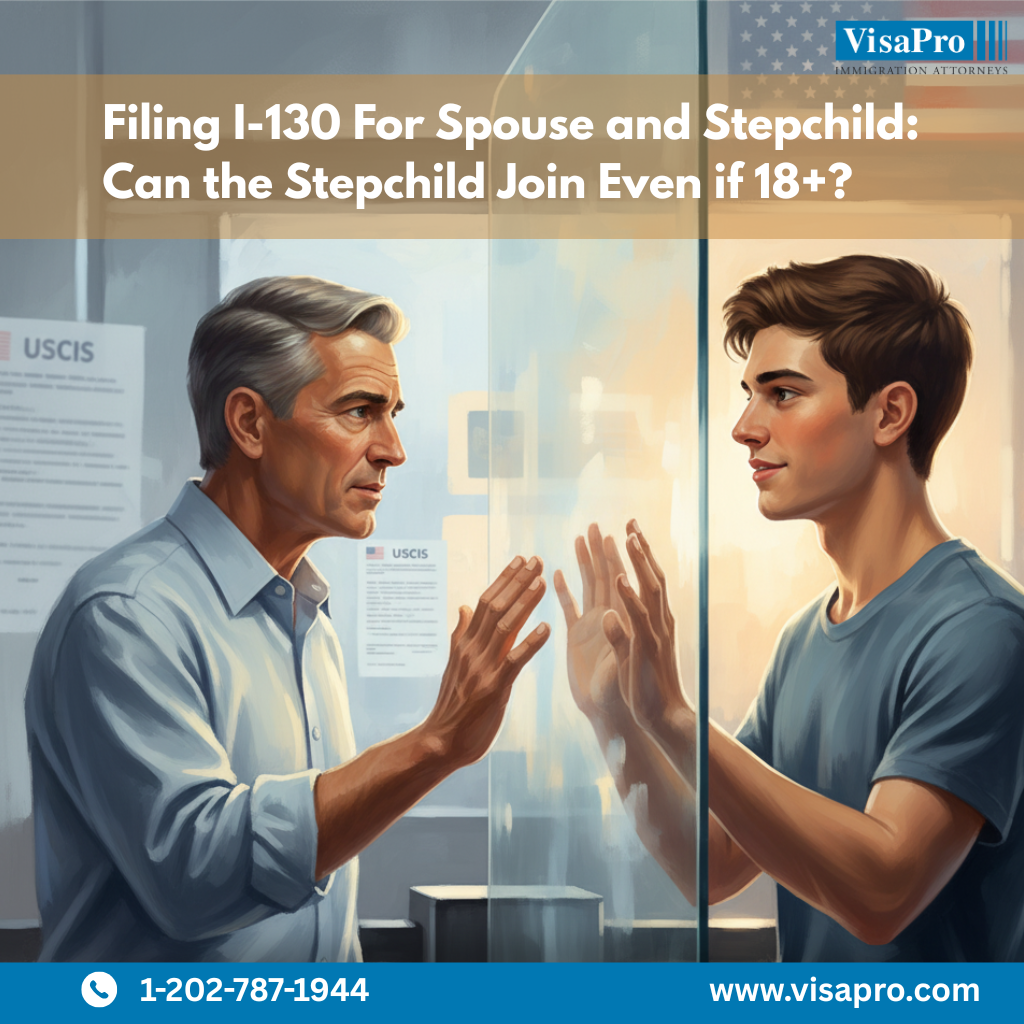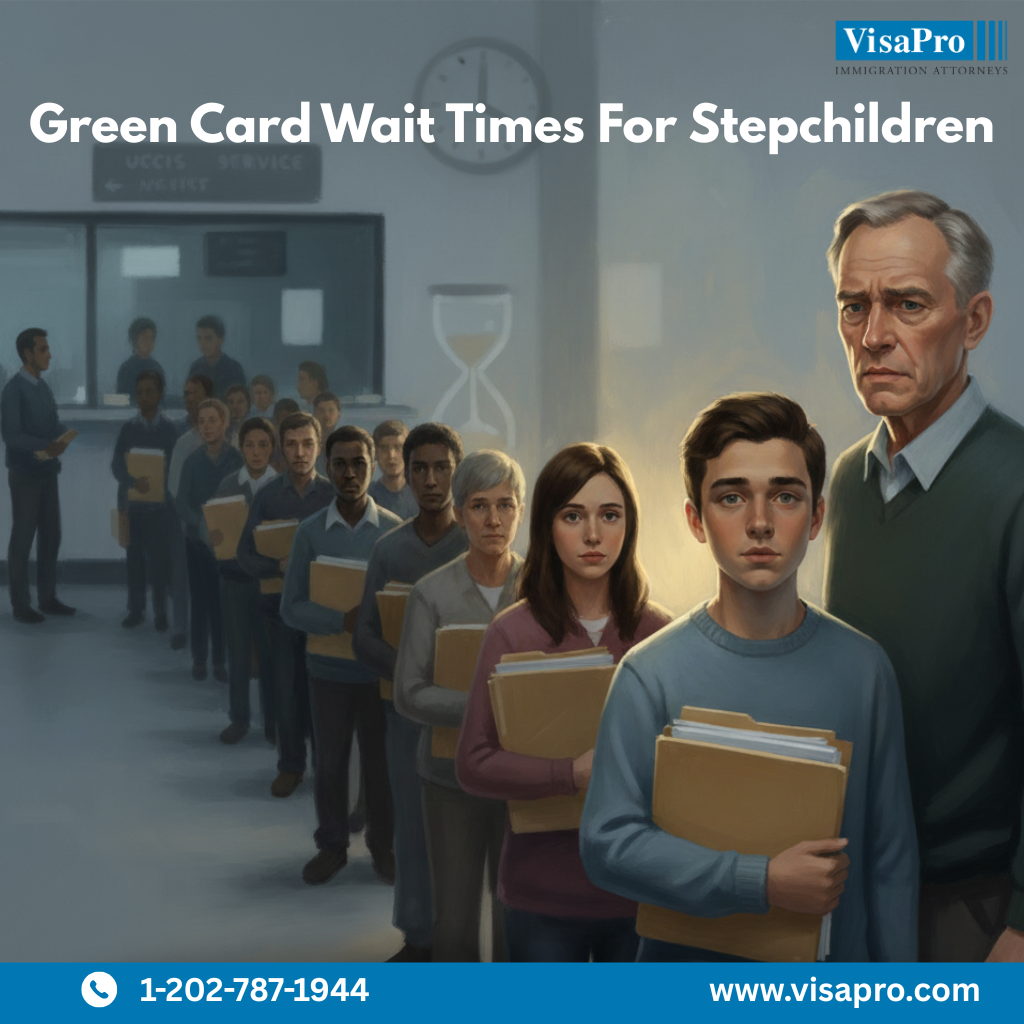Quick Summary:
When you marry or plan on marrying someone with older children, the timing of your marriage dramatically affects their immigration options. Adult stepchildren 18 years old and older do not qualify as a “stepchild” for immigration purposes when you marry their parent. That means they will not qualify as your immediate relative, creating a longer path to permanent residency that requires careful planning and patience.
Understanding I-130 Eligibility Rules for Stepchildren
U.S. citizens can file the Form I-130, Immigrant Petitions for their immediate relatives, which includes their spouse, parents and any children under 21 years old. The immigrant petition allows the US citizen’s immediate relative to obtain a green card and they are not subject to any quotas.
A stepchild can also be considered an immediate relative, but only if the US citizen’s marriage to the child’s parent occurred before the child’s 18th birthday. If the child(ren) have turned 18 at the time of marriage, they cannot be considered your immediate relative under immigration law.
This age cutoff isn’t arbitrary- it reflects the legal principle that immigration benefits for stepchildren are based on the formation of a genuine parent-child relationship during the child’s minority. When a child has already reached adulthood, the law assumes the stepparent relationship is less likely to mirror a traditional parent-child bond for immigration purposes.
The practical impact is significant. Instead of immediate eligibility, your stepchild must now wait for their parent (your spouse) to first obtain permanent residency and then file a separate I-130 petition in a preference category with potential years-long waiting periods.
Many families discover this rule only after consulting an attorney or attempting to file paperwork, leading to disappointment and revised expectations. Understanding this distinction early can help families plan realistic timelines and explore all available options.
Example Scenarios:
- Maria, a U.S. citizen, marries Carlos, a foreign national with a 17-year-old daughter, Ana. Because the marriage took place before Ana’s 18th birthday, Maria may file I-130 petitions for both Carlos and Ana as immediate relatives of a US citizen.
- Rajesh, a U.S. citizen, marries Karina, a foreign national with an 18-year-old son, Sher. Because the marriage took place after Sher’s 18th birthday, Rajesh cannot directly petition for Sher as an immediate relative.
- Jacob, a U.S. citizen, marries Tony, a foreign national whose daughter is turning 18 in just a few weeks. Because the marriage took place before Sarah’s 18th birthday, Jacob can file an I-130 petition for Sarah even after she turns 18.
Filing I-130 For a Stepchild
If your stepchild was 18 before your marriage to their parent took place, you can file the Form I-130 for your spouse and stepchild at the same time or separately. This is because regardless of the stepparent/stepchild relationship, the child is considered an immediate relative of the US citizen.
In fact, even after the child turns 21, the US citizen stepparent can file an I-130 petition in the F1 (unmarried son or daughter of a US citizen) or F3 (married son or daughter of a US citizen) preference categories. These categories, however, have significant backlogs exceeding 5 years.
Filing Form I-130 for a stepchild requires careful attention to documentation, especially when proving the step-relationship and timing of the marriage.
Essential Documentation Checklist:
- Form I-130 properly completed by the petitioner (your permanent resident spouse)
- Petitioner’s green card copy (both sides)
- Birth certificate of the stepchild showing the biological parent’s name
- Marriage certificate showing the date of marriage between you (USC) and the biological parent
- Evidence proving the stepchild was over 18 at the time of marriage
- Passport-style photos of both petitioner and beneficiary
- Filing fee payment ($535 as of 2024)
Proving the Step-Relationship Timeline: The most critical aspect is documenting that your marriage to the biological parent occurred after the child turned 18. USCIS will carefully examine birth certificates and marriage certificates to determine the exact timeline. Even a few days’ difference can change the entire case classification.
Common Documentation Pitfalls: Many families struggle with obtaining certified copies of foreign birth certificates or marriage certificates. Some countries have different documentation standards, and translations must be certified. Starting this documentation process early prevents delays once you’re ready to file.
Processing Timeline Expectations: After filing, expect 8-15 months for initial USCIS processing, followed by National Visa Center processing if approved, then consular processing in the beneficiary’s home country. Total time from filing to green card is typically 2-7 years depending on the category and country.

The Two-Step Process: How Adult Stepchildren Can Eventually Get Green Cards
If your stepchild was over 18 at the time of your marriage, the immigration process becomes a two-step journey that requires patience and careful timing.
Step 1: Your Spouse Gets Their Green Card First Before any petition can be filed for adult stepchildren, your foreign national spouse must first obtain lawful permanent resident status. This could happen through your I-130 petition for them as your spouse, employment-based immigration, or other qualifying pathways.
Step 2: Your Spouse Files an I-130 for Their Child Once your spouse becomes a permanent resident, they can file an I-130 petition for their adult child. The child will be classified in either the F-2A category (unmarried sons and daughters under 21 of permanent residents) or F-2B category (unmarried sons and daughters 21 and older of permanent residents).
This two-step process typically adds 2-5 years to the overall timeline, depending on the child’s age, marital status, and country of birth. For families from countries with high demand like Mexico, India, China, or the Philippines, waiting times can be significantly longer due to per-country limits.
The emotional challenge of this extended separation shouldn’t be underestimated. Families often struggle with the uncertainty and distance, especially when grandchildren or other family milestones are involved during the waiting period.
F-2A vs. F-2B Categories: Which Path Your Stepchild Takes
The specific category your stepchild falls into depends on their age and marital status when the I-130 petition is filed-not when they immigrate.
F-2A Category (Preferred Path) Unmarried Children under 21 when the I-130 is filed qualify for F-2A status. This category typically has shorter waiting times, currently about 2-3 years for most countries. The key advantage is that F-2A beneficiaries are protected by the Child Status Protection Act, which can freeze their age to under 21 for immigration purposes under certain circumstances. It is essential that the child(ren) remain unmarried to continue to qualify for the green card in this category.
F-2B Category (Longer Wait) Unmarried Children who are 21 or older when the I-130 is filed fall into F-2B. This category has longer waiting times, currently about 4-7 years for most countries. There’s no age protection, so time is of the essence in filing the petition. It is essential that the child(ren) remain unmarried to continue to qualify for the green card in this category.
Critical Timing Consideration If your stepchild is approaching age 21, it’s crucial to have their parent file the I-130 petition before they turn 21, even if the priority date isn’t current yet. This may lock them into the faster F-2A category and provides age protection benefits depending on visa wait times.
What Happens if They Marry If your stepchild marries before immigrating, they become ineligible for these categories entirely. If they marry after their parent become a US citizen, the marriage moves them to the F-3 category (married sons and daughters of US citizens), which currently has wait times exceeding 8 years for most countries.
Real-World Scenarios: When Timing Makes the Difference
Scenario 1: The Close Call Maria, a U.S. citizen, married Carlos when his daughter Sofia was 20 years old. Sofia turned 21 just six months after her father obtained his green card. Because Carlos filed the I-130 petition immediately after getting his permanent residency, Sofia qualified for F-2A status at the time of filing. Thankfully, once her I-130 was approved, her CSPA calculation showed she was locked in at under 21 years old. She received her green card in about 3 years instead of the 5+ years she would have waited in F-2B.
Scenario 2: The Missed Opportunity James married Ana when her son Miguel was 19. However, Ana’s green card process took three years due to complications with her documentation. By the time Ana became a permanent resident and could file for Miguel, he was 22 years old. Miguel fell into the F-2B category with a current wait time of approximately 5-7 years.
Scenario 3: The Marriage Complication Patricia became a permanent resident and immediately filed I-130 for her 23-year-old daughter Carmen in F-2B status. Two years into the wait, Carmen married her longtime boyfriend. This marriage automatically terminated her F-2B petition. Once Patricia became a citizens, she had to file a new I-130 petition in the F-3 category, adding another 6+ years to Carmen’s wait.
These scenarios illustrate why early legal consultation and strategic planning are essential. Small timing differences can literally add years to family separation.
Common Mistakes That Delay or Derail Stepchild Petitions
Understanding frequent errors can help you avoid costly delays and potential denials.
Mistake 1: Filing Too Early Some families attempt to file I-130 for the stepchild before the biological parent has obtained permanent residency. Only permanent residents and U.S. citizens can file I-130 petitions, so premature filing results in automatic rejection and lost fees.
Mistake 2: Incorrect Category Classification Filing in F-2A when the child was actually 21 or older at filing, or vice versa, causes significant delays. USCIS may reclassify the petition, but this can add 6-12 months to processing time.
Mistake 3: Failing to Maintain Status If your stepchild is in the U.S. on a temporary visa, failing to maintain lawful status while the I-130 is pending can complicate their case. Some may need to depart and wait abroad for consular processing.
Mistake 4: Not Planning for Derivative Beneficiaries If your stepchild has their own unmarried children under 21, these grandchildren may qualify as derivative beneficiaries if you are filing a petition in the F3 or F1 categories.
I-130 Petition for Stepchild: Legal Strategies and Timing Considerations
Strategic planning can significantly improve outcomes and reduce waiting times for families navigating stepchild immigration cases.
Age Protection Strategies: For stepchildren approaching age 21, timing the permanent resident parent’s I-130 filing becomes critical. The Child Status Protection Act (CSPA) may be able to freeze a child’s age for immigration purposes, but only if the petition is filed before they turn 21 and other conditions are met.
Concurrent Filing Opportunities: In some cases, if your stepchild is in the U.S. on a valid temporary status and a visa number is immediately available, they may be able to file I-485 (adjustment of status) concurrently with the I-130 petition, allowing them to remain in the U.S. during processing.
Expedite Request Considerations: While USCIS rarely grants expedite requests for family-based petitions, certain humanitarian circumstances might qualify. These include serious medical conditions, significant financial hardship, or other emergency situations affecting U.S. citizens or permanent residents.
Country-Specific Planning: Beneficiaries from countries with high immigration demand should plan for longer wait times and consider whether maintaining temporary status in the U.S. during the wait is preferable to returning to their home country or even feasible.
Alternative Pathways Assessment: Experienced immigration attorneys often explore alternative pathways. If you have not actually married your foreign national fiancé, a future stepchild can be included in a Form I-129F Fiancé(e) petition (Form I-129F) until they turn 21 years old, making them eligible for the K-2 visa.
The stepchild might also qualify for other immigration categories independently Children waiting in the F-1, F-2A/F-2B, or F-3 categories may remain abroad until their visa becomes available, or pursue temporary U.S. visas (such as student visas) if eligible.
The waiting period can be emotionally challenging. Families are often separated for years while children remain in their home country. Some strategies to consider include:
- Student Visas (F-1): Children may study in the U.S. while waiting, but must maintain nonimmigrant intent.
- Tourist Visas (B-2): Short visits are possible, though repeated use raises scrutiny.
- Employment-Based Options: In rare cases, adult children may qualify independently for employment-based immigration.
When Professional Legal Help Becomes Essential
While some immigration processes can be handled independently, stepchild cases over 18 often present complexities that benefit from professional legal guidance.
Complex Documentation Issues: When birth certificates, marriage certificates, or other vital documents are from countries with different record-keeping systems, attorneys can navigate the authentication and translation requirements effectively.
Multiple Pending Cases: Families often have several immigration cases running simultaneously, the U.S. citizen’s petition for the foreign spouse, potential adjustment of status applications, and the eventual stepchild petition. Coordinating these cases requires expertise in timing and strategy.
Prior Immigration Violations: If the stepchild or biological parent has previous immigration issues, overstays, denials, or other complications, these can significantly impact the current petition. Attorneys can assess whether waivers are needed or if other remedial action is required.
Country-Specific Complications: Some countries have complicated relationships with U.S. immigration processes, different documentation standards, or political situations that can affect case processing. Attorneys familiar with these issues can provide valuable guidance.
Appeals and Complications: If a petition is denied, appealing the decision or determining whether refiling is more appropriate requires legal expertise. The stakes are high, as incorrect decisions can add years to family separation.
VisaPro’s experienced immigration attorneys understand the emotional and legal complexities of stepchild cases. We’ve helped hundreds of families navigate these challenging situations, and we offer free initial consultations to assess your specific circumstances and develop a personalized strategy.
Frequently Asked Questions (FAQ)
1.Can I file Form I-130 for my stepchild who was 19 when I married their parent?
No, you cannot file I-130 directly for a stepchild who was 18 years old or older when you married their parent. Your spouse must first become a permanent resident, then they can file the I-130 petition for their unmarried child in the F-2A or F-2B preference category.
2.How long does the process take for a stepchild to immigrate to the U.S. if they were too old to be considered a “stepchild” for immigration purposes?
This process will normally follow a 2-step timeline. First, the US citizen must file the Form I-130 for their spouse as an immediate relative, which generally takes 12-24 months. Once your spouse obtains lawful permanent residence, they then file for their child, which takes an additional 3-7 years depending on the child’s age and country of birth.
3.What’s the difference between F-2A and F-2B categories?
F-2A applies to unmarried children under 21 of lawful permanent residents, with current wait times of 2-3 years. F-2B applies to unmarried children 21 and older of lawful permanent residents, with wait times of 5-7 years. Their age when the Form I-130 is filed by their parent determines the category.
4.Can my stepchild visit the U.S. while their I-130 petition is pending?
Yes, your stepchild can potentially visit on a tourist visa (B-2) while their I-130 is pending, but they must demonstrate strong ties to their home country and intent to return. Having a pending immigration petition can make tourist visa approval more challenging.
5.What happens if my stepchild marries while their I-130 is pending?
If your stepchild marries before receiving their green card, it terminates their current F-2A or F-2B petition if your spouse has not yet obtained their citizenship. If your spouse is not a citizen, they will need to file a new I-130 petition in the F-3 category which has much longer wait times (exceeding 8 years) but only after your spouse becomes a US citizen. If your spouse is already a citizen when their child’s marriage takes place, their child’s petition will move to the F-3 (married sons and daughters of a US citizen) category.
6.Do I need a lawyer to file the Form I-130 for a stepchild?
While not legally required, stepchild where the marriage took place after the age of 18 often involve complex timing issues, documentation challenges, and strategic considerations that benefit significantly from professional legal guidance. The consequences of errors can add years to family separation.
7.Can my stepchild’s children be included in their I-130 petition?
Yes, if a petition has been filed in the F-1, F-2A/F-2B or F-3 categories, your stepchild’s unmarried children under 21 can be included as derivative beneficiaries on the same I-130 petition. This allows the entire nuclear family to immigrate together rather than requiring separate petitions.
8.Can my stepchild come to the U.S. on a student visa while waiting for their immigrant visa
Yes, many children pursue F-1 student visas. However, they must prove nonimmigrant intent and maintain lawful status.
What VisaPro Customers Are Saying
The US [B-1] Visa has always been a tough ride, and being denied a few times it makes it even worse. But thanks to VisaPro and their meticulous processing I was granted a Visa. I would like to thank you and all the people involved in making this a success. I would like to recommend VisaPro to all those who seek peace of mind and hassle free Visa processing.”




 Manas Bhat, Director Operations, First Houston Mortgage India
Manas Bhat, Director Operations, First Houston Mortgage India

